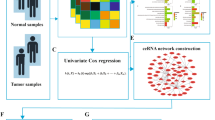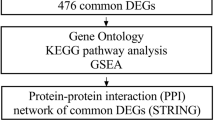Abstract
The study aims to search and identify differentially expressed genes (DEGs) in cervical cancer tissues as novel biomarkers to predict cervical cancer prognosis. The Cancer Genome Atlas (TCGA) data on gene expression profiles in cervical cancer were downloaded and analyzed using R software to identify DEGs in cervical cancer tissues. miRNAs targeted by differentially expressed long non-coding RNAs (DElncRNAs) and mRNAs targeted by microRNAs (miRNAs) were identified using the online miRcode, miRTarBase, TargetScan, and miRDB tools. The ceRNA network and lncRNA expression modules in cervical cancer tissues were constructed using weighted gene co-expression network analysis (WGCNA) and analyzed bioinformatically. The Kaplan–Meier analysis was performed to confirm these DEGs as prognostic markers. Immunohistochemical (IHC) analysis was used to verify expression of the hub genes in 10 paired cervical cancer and normal tissues. A total of 1914 DEmRNAs, 210 DElncRNAs, and 67 DEmiRNAs were identified in cervical cancer samples. There were 39 lncRNAs, 19 miRNAs, and 87 mRNAs involved in the ceRNA network and 25 DElncRNAs, three DEmiRNAs, and four mRNAs involved in the ceRNA sub-network. CACNA1C-AS1 was associated with the yellow and blue modules in the ceRNA sub-network, and LIFR-AS1 was associated with the blue module. The DEmRNAs were involved in cancer-related pathways, and three hub genes (i.e., E2F1, CCNB1, and CCNE1) were highly expressed in cervical squamous cell carcinoma and adenocarcinoma tissues and associated with the prognosis of patients. The ceRNA network and WGCNA analyses are useful to identify novel DEGs that can serve as prognostic markers in cervical cancer. The DEGs will be validated in future studies.






Similar content being viewed by others
Data Availability
Upon request.
References
Bray F, Ferlay J, Soerjomataram I, et al. Global cancer statistics 2018: GLOBOCAN estimates of incidence and mortality worldwide for 36 cancers in 185 countries. CA Cancer J Clin. 2018;68(6):394–424.
Kumar R, Kala P, Narayanan GS, et al. Evaluation and evolution of apparent diffusion coefficient (ADC) in image-guided adaptive brachytherapy (IGABT) for cervical cancer. Brachytherapy. 2021;20(1):112–7.
Klopp AH. Introduction: Cervical cancer. Semin Radiat Oncol. 2020;30(4):263–4.
Lemp JM, De Neve JW, Bussmann H, et al. Lifetime prevalence of cervical cancer screening in 55 low- and middle-income countries. JAMA. 2020;324(15):1532–42.
Abdel-Wahab M, Grover S, Zubizarreta EH, et al. Addressing the burden of cervical cancer through IAEA global brachytherapy initiatives. Brachytherapy. 2020;19(6):850–6.
Malikova H, Burghardtova M, Fejfarova K, et al. Advanced cervical cancer in young women: imaging study of late and very late radiation-related side effects after successful treatment by combined radiotherapy. Quant Imaging Med Surg. 2021;11(1):21–31.
Bartel DP. MicroRNAs: target recognition and regulatory functions. Cell. 2009;136(2):215–33.
Hung T, Chang HY. Long noncoding RNA in genome regulation: prospects and mechanisms. RNA Biol. 2010;7(5):582–5.
Ko NY, Chen LR, Chen KH. The role of micro RNA and long-non-coding RNA in osteoporosis. Int J Mol Sci. 2020;21(14):4886.
Wang Y, Wang Y, Qin Z, et al. The role of non-coding RNAs in ABC transporters regulation and their clinical implications of multidrug resistance in cancer. Expert Opin Drug Metab Toxicol. 2021;17(3):291–306.
Qi X, Zhang DH, Wu N, et al. ceRNA in cancer: possible functions and clinical implications. J Med Genet. 2015;52(10):710–8.
Conte F, Fiscon G, Sibilio P, et al. An overview of the computational models dealing with the regulatory ceRNA mechanism and ceRNA deregulation in cancer. Methods Mol Biol. 2021;2324:149–64.
Langfelder P, Horvath S. WGCNA: an R package for weighted correlation network analysis. BMC Bioinformatics. 2008;9:559.
Goodall GJ, Wickramasinghe VO. RNA in cancer. Nat Rev Cancer. 2021;21(1):22–36.
Bai X, Wang W, Zhao P, et al. LncRNA CRNDE acts as an oncogene in cervical cancer through sponging miR-183 to regulate CCNB1 expression. Carcinogenesis. 2020;41(1):111–21.
Ji YY, Meng M, Miao Y. lncRNA SNHG1 promotes progression of cervical cancer through miR-195/NEK2 axis. Cancer Manag Res. 2020;12:11423–33.
Cui X, Wang X, Zhou X, et al. miR-106a regulates cell proliferation and autophagy by targeting LKB1 in HPV-16-associated cervical cancer. Mol Cancer Res. 2020;18(8):1129–41.
Maass PG, Luft FC, Bahring S. Long non-coding RNA in health and disease. J Mol Med (Berl). 2014;92(4):337–46.
Gupta RA, Shah N, Wang KC, et al. Long non-coding RNA HOTAIR reprograms chromatin state to promote cancer metastasis. Nature. 2010;464(7291):1071–6.
Gibb EA, Brown CJ, Lam WL. The functional role of long non-coding RNA in human carcinomas. Mol Cancer. 2011;10:38.
Wang Q, Wu J, Huang H, et al. lncRNA LIFR-AS1 suppresses invasion and metastasis of non-small cell lung cancer via the miR-942-5p/ZNF471 axis. Cancer Cell Int. 2020;20:180.
Xu F, Li H, Hu C. LIFR-AS1 modulates Sufu to inhibit cell proliferation and migration by miR-197-3p in breast cancer. Biosci Rep. 2019;39(7):BSR20180551.
Wang HF, Lv JQ, Li HH, et al. High long non-coding LIFR-AS1 expression correlates with poor survival in gastric carcinoma. Eur Rev Med Pharmacol Sci. 2020;24(10):5378–84.
Muller H, Bracken AP, Vernell R, et al. E2Fs regulate the expression of genes involved in differentiation, development, proliferation, and apoptosis. Genes Dev. 2001;15(3):267–85.
Biswas AK, Johnson DG. Transcriptional and nontranscriptional functions of E2F1 in response to DNA damage. Cancer Res. 2012;72(1):13–7.
Berton TR, Mitchell DL, Guo R, et al. Regulation of epidermal apoptosis and DNA repair by E2F1 in response to ultraviolet B radiation. Oncogene. 2005;24(15):2449–60.
Engelmann D, Putzer BM. The dark side of E2F1: in transit beyond apoptosis. Cancer Res. 2012;72(3):571–5.
Smits VA, Medema RH. Checking out the G(2)/M transition. Biochim Biophys Acta. 2001;1519(1–2):1–12.
Suzuki T, Urano T, Miki Y, et al. Nuclear cyclin B1 in human breast carcinoma as a potent prognostic factor. Cancer Sci. 2007;98(5):644–51.
Jin J, Xu H, Li W, et al. LINC00346 acts as a competing endogenous RNA regulating development of hepatocellular carcinoma via modulating CDK1/CCNB1 axis. Front Bioeng Biotechnol. 2020;8:54.
Li S, Liu N, Piao J, et al. CCNB1 expedites the progression of cervical squamous cell carcinoma via the regulation by FOXM1. Onco Targets Ther. 2020;13:12383–95.
Zhang S, Iyer S, Ran H, et al. Genetically defined, syngeneic organoid platform for developing combination therapies for ovarian cancer. Cancer Discov. 2021;11(2):362–83.
Huang X, Shao D, Wu H, et al. Genomic profiling comparison of germline BRCA and non-BRCA carriers reveals CCNE1 amplification as a risk factor for non-BRCA carriers in patients with triple-negative breast cancer. Front Oncol. 2020;10:583314.
Konstantinopoulos PA, Ceccaldi R, Shapiro GI, et al. Homologous recombination deficiency: exploiting the fundamental vulnerability of ovarian cancer. Cancer Discov. 2015;5(11):1137–54.
Funding
This study was supported in part by grants from the National Natural Science Foundation of China (#81660434) and the Natural Science Foundation of Guangxi (#2018GXNSFAA050098).
Author information
Authors and Affiliations
Contributions
Xiaoxia Hu and Yongjin Luo conceived and designed the experiments; Zhen Liu and Xiaoxia Hu prepared the manuscript; Yongjin Luo analyzed the data.
Corresponding author
Ethics declarations
Consent for Publication
Consent to publish has been obtained from the participants.
Conflict of Interest
The authors declare no competing interests.
Additional information
Publisher's Note
Springer Nature remains neutral with regard to jurisdictional claims in published maps and institutional affiliations.
Supplementary Information
Below is the link to the electronic supplementary material.
Rights and permissions
Springer Nature or its licensor (e.g. a society or other partner) holds exclusive rights to this article under a publishing agreement with the author(s) or other rightsholder(s); author self-archiving of the accepted manuscript version of this article is solely governed by the terms of such publishing agreement and applicable law.
About this article
Cite this article
Luo, Y., Liu, Z. & Hu, X. ceRNA Network and WGCNA Analyses of Differentially Expressed Genes in Cervical Cancer Tissues for Association with Survival of Patients. Reprod. Sci. (2024). https://doi.org/10.1007/s43032-024-01477-z
Received:
Accepted:
Published:
DOI: https://doi.org/10.1007/s43032-024-01477-z




